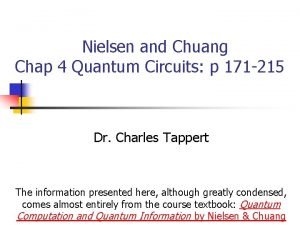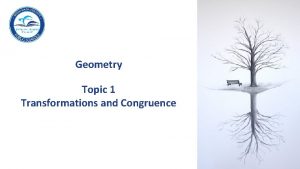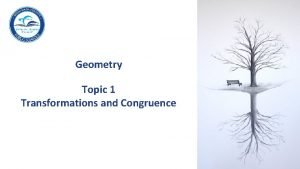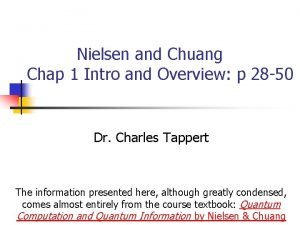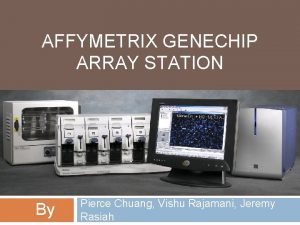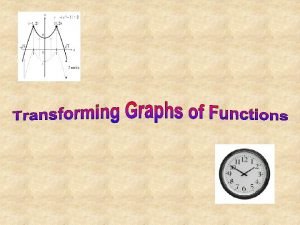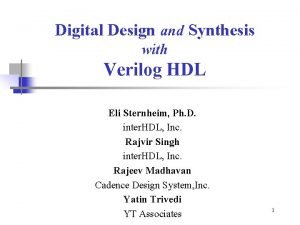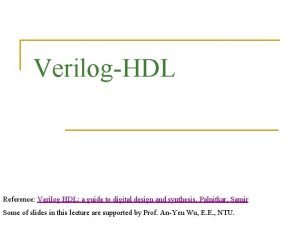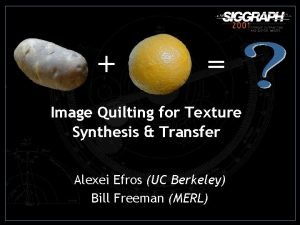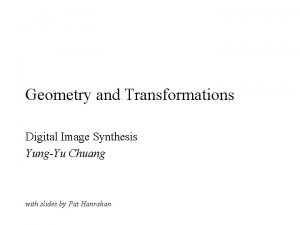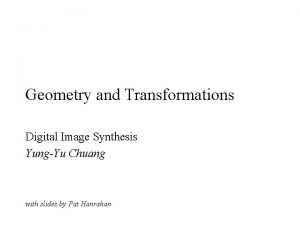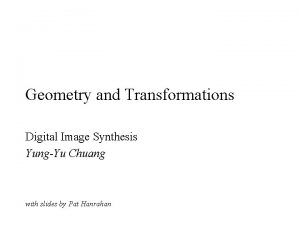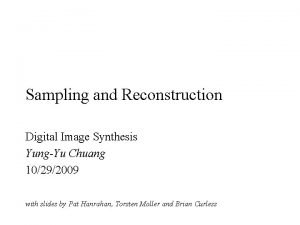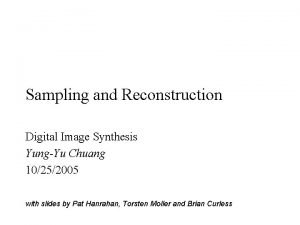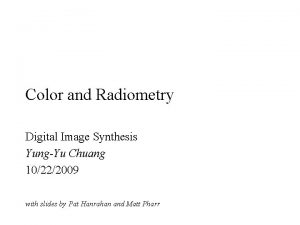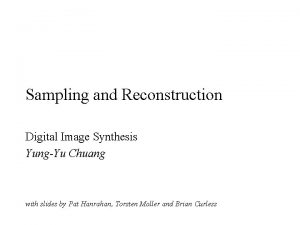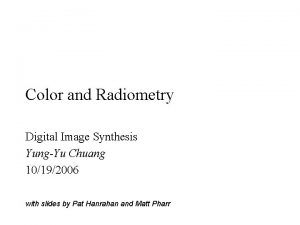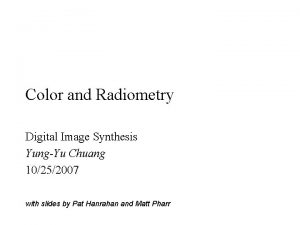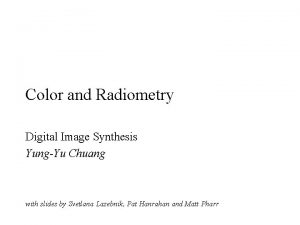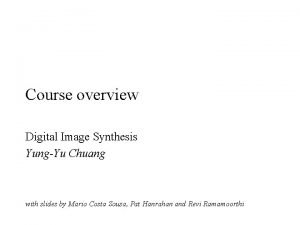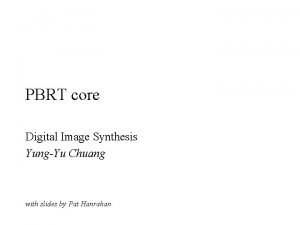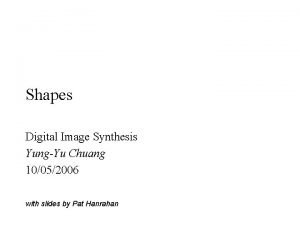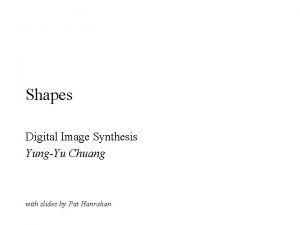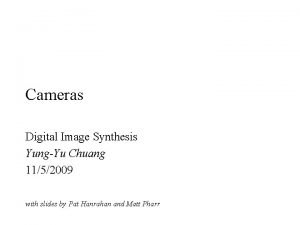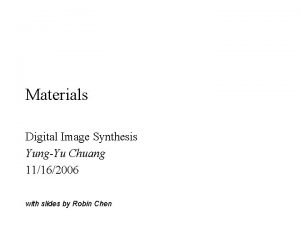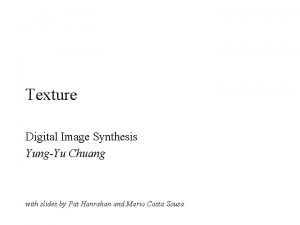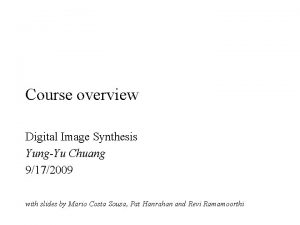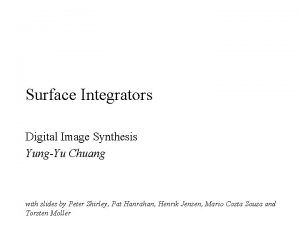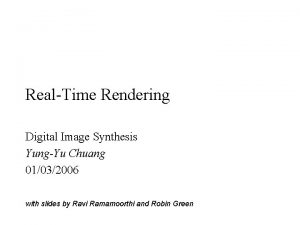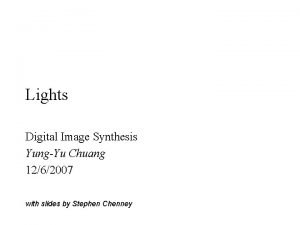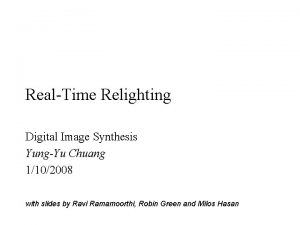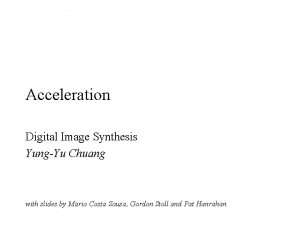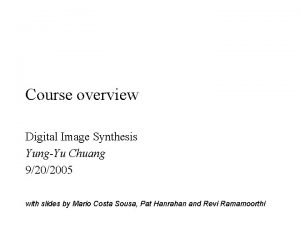Geometry and Transformations Digital Image Synthesis YungYu Chuang

























![Rotation around an arbitrary axis m[0][0]=a. x*a. x + (1. f-a. x*a. x)*c; m[1][0]=a. Rotation around an arbitrary axis m[0][0]=a. x*a. x + (1. f-a. x*a. x)*c; m[1][0]=a.](https://slidetodoc.com/presentation_image_h2/a1b88f21439f51a7f8c63c66f2f81822/image-26.jpg)




- Slides: 30

Geometry and Transformations Digital Image Synthesis Yung-Yu Chuang 9/24/2008 with slides by Pat Hanrahan

Geometric classes • Representation and operations for the basic mathematical constructs like points, vectors and rays. • Actual scene geometry such as triangles and spheres are defined in the “Shapes” chapter. • core/geometry. * and core/transform. * • Purposes of learning this chapter – Get used to the style of learning by tracing source code – Get familiar to the basic geometry utilities because you will use them intensively later on

Coordinate system • Points, vectors and normals are represented with three floating-point coordinate values: x, y, z defined under a coordinate system. • A coordinate system is defined by an origin po and a frame (linearly independent vectors vi). • A vector v= s 1 v 1 +…+snvn represents a direction, while a point p= po+s 1 v 1 +…+snvn represents a position. They are not freely interchangeable. • pbrt uses left-handed coordinate system. y (0, 1, 0) (0, 0, 0) z (0, 0, 1) world space (1, 0, 0) x

Vectors class Vector { public: <Vector Public Methods> float x, y, z; } no need to use selector (get. X) and mutator (set. X) because the design gains nothing and adds bulk to its usage Provided operations: Vector u, v; float a; v+u, v-u, v+=u, v-=u -v (v==u) a*v, v*=a, v/=a a=v[i], v[i]=a

Dot and cross product Dot(v, u) Abs. Dot(v, u) Cross(v, u) Vectors v, u, v×u form a frame u θ v

Normalization a=Length. Squared(v) a=Length(v) u=Normalize(v) return a vector, does not normalize in place

Coordinate system from a vector Construct a local coordinate system from a vector. inline void Coordinate. System(const Vector &v 1, Vector *v 2, Vector *v 3) { if (fabsf(v 1. x) > fabsf(v 1. y)) { float inv. Len = 1. f/sqrtf(v 1. x*v 1. x + v 1. z*v 1. z); *v 2 = Vector(-v 1. z * inv. Len, 0. f, v 1. x * inv. Len); } else { float inv. Len = 1. f/sqrtf(v 1. y*v 1. y + v 1. z*v 1. z); *v 2 = Vector(0. f, v 1. z * inv. Len, -v 1. y * inv. Len); } *v 3 = Cross(v 1, *v 2); }

Points are different from vectors; given a coordinate system (p 0, v 1, v 2, v 3), a point p and a vector v with the same (x, y, z) essentially means p=(x, y, z, 1)[v 1 v 2 v 3 p 0]T v=(x, y, z, 0)[v 1 v 2 v 3 p 0]T explicit Vector(const Point &p); You have to convert a point to a vector explicitly (i. e. you know what you are doing). Vector v=p; Vector v=Vector(p);

Operations for points Vector v; Point p, q, r; float a; q q=p+v; q=p-v; v=q-p; r=p+q; a*p; p/a; v p (This is only for the operation αp+βq. ) Distance(p, q); Distance. Squared(p, q);

Normals • A surface normal (or just normal) is a vector that is perpendicular to a surface at a particular position.

Normals • Different than vectors in some situations, particularly when applying transformations. • Implementation similar to Vector, but a normal cannot be added to a point and one cannot take the cross product of two normals. • Normal is not necessarily normalized. • Only explicit conversion between Vector and Normal.

Rays class Ray { public: <Ray Public Methods> (They may be changed even if Ray is const. Point o; This ensures that o and d are not modified, Vector d; but mint and maxt can be. ) mutable float mint, maxt; Initialized as RAY_EPSILON to float time; avoid self intersection. (for motion blur) }; Ray r(o, d); Point p=r(t); maxt d o mint

Rays Ray(): mint(RAY_EPSILON), maxt(INFINITY), time(0. f) {} The reason why we need epsilon. Unfortunately, there is not a universal epsilon that works for all scenes.

Ray differentials • Subclass of Ray with two auxiliary rays. Used to estimate the projected area for a small part of a scene and for antialiasing in Texture. class Ray. Differential : public Ray { public: <Ray. Differential Methods> bool has. Differentials; Ray rx, ry; };

Bounding boxes • To avoid intersection test inside a volume if the ray doesn’t hit the bounding volume. • Benefits depends on the expense of testing volume v. s. objects inside and the tightness of the bounding volume. • Popular bounding volume, sphere, axis-aligned bounding box (AABB), oriented bounding box (OBB) and slab.

Bounding volume (slab)

Bounding boxes class BBox { public: <BBox Public Methods> Point p. Min, p. Max; } Point p, q; BBox b; float delta; bool s; two options b = BBox(p, q) // no order for p, q of storing b = Union(b, p) b = Union(b, b 2) b = b. Expand(delta) s = b. Overlaps(b 2) s = b. Inside(p) Volume(b) b. Maximum. Extent() which axis is the longest; for building kd-tree b. Bounding. Sphere(c, r) for generating samples

Transformations • p’=T(p); v’=T(v) • Only supports transforms with the following properties: – Linear: T(av+bu)=a. T(v)+b. T(u) – Continuous: T maps the neighbors of p to ones of p’ – Ont-to-one and invertible: T maps p to single p’ and T-1 exists • Represented with a 4 x 4 matrix; homogeneous coordinates are used implicitly • Can be applied to points, vectors and normals • Simplify implementations (e. g. cameras and shapes)

Transformations • More convenient, instancing scene primitive scene graph primitive

Transformations class Transform {. . . private: Reference<Matrix 4 x 4> m, m. Inv; } save space, but can’t be modified after construction Usually not a problem because transforms are pre-specified in the scene file and won’t be changed during rendering. Transform() {m = m. Inv = new Matrix 4 x 4; } Transform(float mat[4][4]); Transform(const Reference<Matrix 4 x 4> &mat, A better way const Reference<Matrix 4 x 4> &minv); to initialize

Transformations • Translate(Vector(dx, dy, dz)) • Scale(sx, sy, sz) • Rotate. X(a) because R is orthogonal

Example for creating common transforms Transform Translate(const Vector &delta) { Matrix 4 x 4 *m, *minv; m = new Matrix 4 x 4(1, 0, 0, delta. x, 0, 1, 0, delta. y, 0, 0, 1, delta. z, 0, 0, 0, 1); minv = new Matrix 4 x 4(1, 0, 0, -delta. x, 0, 1, 0, -delta. y, 0, 0, 1, -delta. z, 0, 0, 0, 1); return Transform(m, minv); }

Rotation around an arbitrary axis • Rotate(theta, axis) a v θ v’ axis is normalized

Rotation around an arbitrary axis • Rotate(theta, axis) a v v 1 p θ v 2 v’ axis is normalized

Rotation around an arbitrary axis • Rotate(theta, axis) M axis is normalized v =
![Rotation around an arbitrary axis m00a xa x 1 fa xa xc m10a Rotation around an arbitrary axis m[0][0]=a. x*a. x + (1. f-a. x*a. x)*c; m[1][0]=a.](https://slidetodoc.com/presentation_image_h2/a1b88f21439f51a7f8c63c66f2f81822/image-26.jpg)
Rotation around an arbitrary axis m[0][0]=a. x*a. x + (1. f-a. x*a. x)*c; m[1][0]=a. x*a. y*(1. f-c) + a. z*s; m[2][0]=a. x*a. z*(1. f-c) - a. y*s; M v 1 0 0 0 =

Look-at • Look. At(Point &pos, Point look, Vector &up) up is not necessarily perpendicular to dir look up pos Vector dir=Normalize(look-pos); Vector right=Cross(dir, Normalize(up)); Vector new. Up=Cross(right, dir); pos

Applying transformations Point: (p, 1) • Point: q=T(p), T(p, &q) Vector: (v, 0) use homogeneous coordinates implicitly • Vector: u=T(v), T(u, &v) • Normal: treated differently than vectors because of anisotropic transformations M • Transform should keep its inverse • For orthonormal matrix, S=M

Applying transformations • BBox: transforms its eight corners and expand to include all eight points. BBox Transform: : operator()(const BBox &b) const { const Transform &M = *this; BBox ret( M(Point(b. p. Min. x, b. p. Min. y, b. p. Min. z))); ret = Union(ret, M(Point(b. p. Max. x, b. p. Min. y, b. p. Min. z))); ret = Union(ret, M(Point(b. p. Min. x, b. p. Max. y, b. p. Min. z))); ret = Union(ret, M(Point(b. p. Min. x, b. p. Min. y, b. p. Max. z))); ret = Union(ret, M(Point(b. p. Min. x, b. p. Max. y, b. p. Max. z))); ret = Union(ret, M(Point(b. p. Max. x, b. p. Max. y, b. p. Min. z))); ret = Union(ret, M(Point(b. p. Max. x, b. p. Min. y, b. p. Max. z))); ret = Union(ret, M(Point(b. p. Max. x, b. p. Max. y,

Differential geometry • Differential. Geometry: a self-contained representation for a particular point on a surface so that all the other operations in pbrt can be executed without referring to the original shape. It contains • Position • Parameterization (u, v) • Parametric derivatives (dp/du, dp/dv) • Surface normal (derived from (dp/du)x(dp/dv)) • Derivatives of normals • Pointer to shape
 Image geometry in digital image processing
Image geometry in digital image processing Maketform
Maketform Analog image and digital image
Analog image and digital image Nielsen and chuang solutions chapter 4
Nielsen and chuang solutions chapter 4 Geometry topic 1 review
Geometry topic 1 review Congruent segments
Congruent segments Image transform in digital image processing
Image transform in digital image processing Optimum notch filter in digital image processing
Optimum notch filter in digital image processing Arithmetic coding in digital image processing
Arithmetic coding in digital image processing Image segmentation in digital image processing
Image segmentation in digital image processing Fidelity criteria in image compression
Fidelity criteria in image compression Image sharpening in digital image processing
Image sharpening in digital image processing False contouring
False contouring Walsh transform in digital image processing
Walsh transform in digital image processing Image restoration in digital image processing
Image restoration in digital image processing Chuang qian ming yue guang li bai
Chuang qian ming yue guang li bai Chi zao fan
Chi zao fan Nielsen chuang
Nielsen chuang Cs399
Cs399 Pierce chuang
Pierce chuang Chuang
Chuang Cathy chuang
Cathy chuang Rosalind chuang
Rosalind chuang Chuang pronunciation
Chuang pronunciation Multiple transformations geometry
Multiple transformations geometry Lewis structure for pf3
Lewis structure for pf3 Cache verilog
Cache verilog Verilog hdl: a guide to digital design and synthesis
Verilog hdl: a guide to digital design and synthesis Image quilting for texture synthesis and transfer
Image quilting for texture synthesis and transfer What are intensity transformations?
What are intensity transformations? Electron domain geometry vs molecular geometry
Electron domain geometry vs molecular geometry



